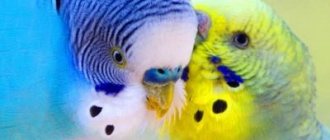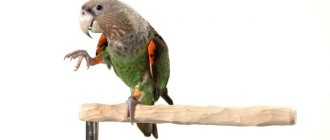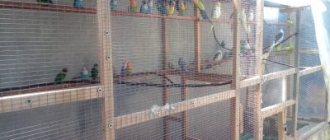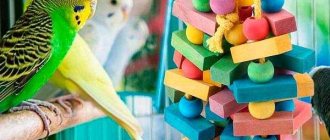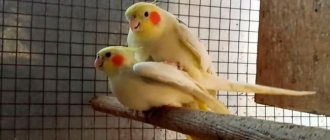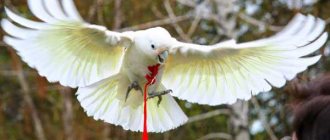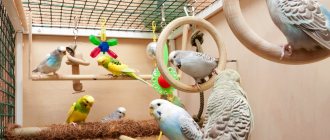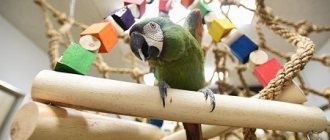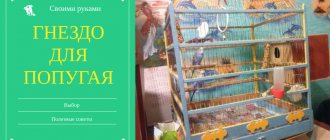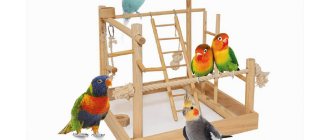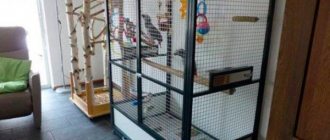If you have an opposite-sex pair of parrots living at home, and you are going to get offspring from them, sooner or later you will have to start building a house. Only in a nest for budgerigars can the mystery of the birth of chicks take place. How to understand that the time has come for reproduction, and which house to choose - you will find out by reading the article.
Making a nest for a budgerigar
Read in this article
Breeding budgies in captivity is an interesting process, but also quite troublesome. It is important not only to form a pair correctly, but also to provide the birds with everything necessary for successful breeding at home.
Many people know that parrots in their natural habitat prefer to nest in the hollows of various trees, so in captivity they will need a nesting house.
How to make a nest for budgies with your own hands? For this you will need the following materials:
- wooden boards (4 pcs.);
- plywood;
- hammer, nails and screws;
- Ruler and pencil;
- saw or hacksaw for cutting wood;
- electric drill.
Types of nesting houses
There is no need for parrot owners to go into the forest to find a littered, dried tree with a large hollow. A parrot house, practical and safe, can be purchased ready-made or made by yourself.
The choice is between rectangular structures, which differ in the ratio of width, length and height. Each option has its own advantages and disadvantages. The common feature is wood as a material for production and the size of the hole is approximately 50 mm in diameter. The female will be able to expand the cage if necessary. She uses her beak, which she uses to bite off excess wood.
Horizontal design
A parrot house with a width and length of 20x25 cm and a height of 15 cm is called horizontal. The site is quite spacious. It is convenient for the female to hatch eggs and climb into the house without damaging the clutch.
The downside is the following: the height of the house is small, the entrance hole is located very low. Still immature chicks can fall out.
Vertical design
A house with a width and length of 20 cm, a height of 25 cm is called vertical. Little chicks will not get out of the nest ahead of time. But the exit from the house is located at a high altitude. If the female climbs into it carelessly, there is a risk of crushing the eggs or chicks that hatch last.
Compromise option
A compromise solution is the size of the house 25x20 cm, 20 cm high. The area is sufficient for the female to move around. Small parrots will not have the opportunity to accidentally crawl out. A step, which is made at the bottom under a 6x3 cm perch, helps the female to safely settle on the clutch. The chicks will be safe.
Choosing the optimal type of nesting site
So, let's look at 3 types of nesting houses for parrots. A vertical housing is characterized by a high location of the entrance, which increases the likelihood of damage to eggs by birds. But the chicks cannot fall out of it.
In a horizontal house, the eggs will be reliably protected, in addition, the grown chicks will look out of it and watch with interest what is happening in the room. Parrots will really like the combined nest box, because it combines the advantages of the previous options. Such a dwelling is spacious enough and convenient for raising a large number of chicks.
Anyone can make a house for budgies with their own hands.
Simple vertical house
It is best to make a vertical house for budgies with your own hands from hardwood boards, the thickness of which is no more than 20 mm. First you need to carefully cut out the front, back and side walls of the box. All parts must be the same length and width! The standard dimensions of a home for a pair of budgies are 15 x 15 x 25 cm. Now you can connect the walls of the future home with nails. The bottom of a smooth board should fit them perfectly. To prevent the female from scattering eggs and small chicks along the bottom of the nesting house, it is recommended to make a slight depression in it.
The diameter of the tap hole (inlet) in the front wall of the box is 50 mm. It can be cut using a drill. It is also worth making cutouts. After all, fresh air is very important for the full development of eggs and chicks. It is advisable to attach a piece of plywood inside the nest box as a lip to protect the eggs. Otherwise, the parrot risks damaging them.
It is necessary to drill a hole under the finished taphole to fix a short perch. This is done to make it convenient for birds to enter the home. After all the structural parts are connected to each other, the box must be covered with a lid. A simple and convenient nesting box for parrots is ready! You can secure it to the cage using wire or hooks.
Combined nesting house
A nest box of a combined type is suitable for large budgies. Such a dwelling is quite spacious, so the female does not risk damaging the clutch, and the growing chicks will not be able to leave it prematurely. To make it you will need the same materials as for the vertical house. The height of the combined nesting box is at least 20 cm, and the internal size of the bottom is 22 x 15 cm. The entrance with a perch is located 2.5 cm from the ceiling and front wall. Inside the nest box you need to make a step 3 cm high so that the parrots can comfortably enter it. Do not forget that you need to make a round depression at the bottom for eggs and chicks.
It is recommended to equip such a nesting box with a hinged lid. This way, it will be possible to carry out a daily inspection of the box and remove dirt in a timely manner. The removable cover can be installed using hinges and screws.
Horizontal nest box
How to make a horizontal type nest for budgerigars? It is no secret that this type of nest box is very convenient for the female and her offspring. Kids will be able to look out of it and watch the adult birds with interest. In fact, a horizontal dwelling is designed in the same way as a vertical one.
In the process of making such a nest, you will need the same wooden boards, plywood and nails. From a wooden board you need to carefully cut 2 rectangles measuring 25 x 15 cm, which will serve as the front wall and bottom of the home. Then cut out the side walls in the same way. The recommended size is 15 x 14 cm. Use a sheet of plywood to make a back wall (23 x 15 cm) and a lid (25 x 15 cm) for the house. Using nails, fasten the front wall and the bottom of the future nesting box, then attach the side walls to the edges.
How to hang a nest box
It can be fixed outside or installed inside the cage. The first method is suitable if the cell is too small. But the female is more comfortable if the nesting area is located directly at the bottom of the cage. In this case, the male usually spends a lot of time on the roof of the house, which serves as a kind of support for the second parrot.
The cage must be spacious so that a person can lift the nest lid to carry out hygiene procedures or monitor the condition of the chicks. Fixation is done with wire or strands. It is important to ensure that the cage bars are highly durable and reliable. If the nest is suspended, you need to make sure that it cannot fall when there is masonry in it.
Breeding parrots should only be done in a quiet, warm and bright room, since if it is too noisy, the chicks will be afraid and therefore will not leave the nest on time.
Nest house for budgies
A nest box is an ideal nesting site for birds that nest in tree hollows. A house in the form of a nest is practically no different from the home of parrots in nature. Its design is simple, but making a nest box at home is more difficult than nesting boxes made from boards.
To make a nesting box in the form of a nest box you will need the following materials:
- a log with a rotten core or a block of wood of any species;
- thick board as a roof;
- large nails;
- chisel and electric drill.
How to make a natural-shaped nest for budgies? The diameter of the dwelling must be at least 22 cm, and the height of the finished nest should not exceed 40 cm. A hole must be made from the middle of the log, gradually expanding its diameter. A chisel is best suited for this. The inside of such a house should be round. The thickness of its walls is no more than 2 cm. Also, the core of the log can be removed using a drill. The inlet hole is drilled carefully, its diameter must be at least 50 mm. For large budgerigars it is recommended to increase it to 60 mm. The nest box roof can be secured with rope or simply placed on top. Budgerigars will certainly appreciate such a nesting site!
It is recommended to install the parrot house outside in order to save space in the cage. Cages with several doors are often found on sale, which involves installing a nesting box in any part of the cage. Birch or linden sawdust can be poured into the bottom of the box as bedding. But if the female decides to throw them out of the nest, there is no need to worry, since parrots can do without nesting material.
What you need to prepare for the design
If you plan to create a nest yourself, then you need to prepare the following elements:
- drawing of the future nest;
- wooden boards, and they can be obtained by destroying an ordinary wooden box;
- boards can be replaced with plywood, but it is not recommended to use chipboard, as this material is of low quality;
- screws and hammer;
- wooden perch;
- special fastenings with which the nest is fixed to the walls of the cage.
It is advisable to treat with antiseptics before connecting all the parts, which will greatly simplify the work.
The photo shows one of the drawing options for making a nest:
When to build a nest for budgerigars
Poultry farmers often complain about the lack of offspring when keeping a pair of parrots. Experts explain this nuance by the natural instincts of motherhood that arise in females in a secluded place in the form of a hollow.
In cages not equipped for such purposes, birds do not have any need to incubate offspring. Therefore, if you purposefully intend to breed tropical birds, you definitely need to install an additional nesting house in their abode.
It has been noticed that fertilization processes are much more successful in those cells where several couples live. This is explained by the gregarious lifestyle of pets.
To determine their age categories, experienced poultry farmers advise paying attention to the following signs:
- the presence of a pattern on the head that reaches the beak itself is typical only for young individuals that have reached several months;
- absence of a pattern above the wax of the beak - disappears after the first moult (budgerigars molt for the first time at the age of 4 to 6 months);
- the absence of an iris around the eye indicates that the bird has reached 6–7 months (the wider it is, the older the ward).
Is it necessary for the cage?
If an individual lives alone, then there is no need for filler as such. In addition, some budget cells exclude the possibility of loading it in principle. But when the tray is retractable, there are no problems with filling.
If the owner has no plans for bird offspring, then it is quite possible to get by with an ordinary sheet of paper. The droppings are clearly visible on it, which makes it possible to diagnose many diseases in the early stages.
Cleaning is also simple: replace the sheet with a new one and that’s it. But once a week, the cage still needs general cleaning along with disinfection of accessories.
DIY nesting house for parrots
Owners of domestic talkers do not need to look for suitable hollows to breed them. It is quite possible to make the required structure yourself from scrap materials. We will discuss the necessary materials and actions in detail below.
Design and dimensions
First of all, the master must decide on the dimensions of the structure being created and prepare the corresponding drawings. According to zoo standards, the length of the sides of the nesting room for one pair of budgerigars should be at least 10 cm.
However, at the design stage of the structure, the breeder may prefer the following house options:
- vertical - its width and length are 20 cm, and its height is 25 cm. Its advantage is that the parrots will not be able to fly out of the nest too early, but the high location of the exit creates a risk of damage to the female’s clutch;
- horizontal - its width is 25 cm, length - 20 cm, height - 15 cm. It is convenient because the bottom area does not allow the female to damage the masonry when entering the house, but the chicks can easily get out of the nest ahead of time;
- compromise - its dimensions correspond to a width of 25 cm, a length and a height of 20 cm. The dimensions of the nest allow the chicks to grow up not in crowded conditions, and the latest parrots do not risk being crushed.
Which ones are best for wavy birds?
The best and most affordable option is pine needles . If you don’t want to overpay for store-bought options, you can buy a bag in bulk from any industry: furniture, construction/finishing materials, etc. Some breeders use beech litter. It is considered more environmentally friendly and safer for chicks, but not every female will agree to this option.
You should not look towards exotic solutions, such as coconut flakes. They may cause an allergic reaction. It’s good if the latter is obvious, but if it is asymptomatic, there is a risk of ruining the bird’s immune system. And this will open the door to a variety of diseases.
How to make a nest
Since budgerigars never make nests from branches, twigs and feathers, the breeder must help his charges with arranging the abode.
This process is carried out using high-quality sawdust or dried medicinal chamomile flowers. The material is simply poured onto the bottom of the homemade structure as bedding. Moreover, experts do not place any restrictions on the use of certain tree species for bedding material. Make sure there is enough of it.
In the future, the breeder will need to periodically remove the old litter, replacing it with new one. Also, disinfection will not hurt the health of bird offspring.
Experts advise planning the first cleaning for the period when the chicks are 14 days old. They will need to be carefully removed from the nest through the removed lid and temporarily transplanted into a small cardboard box. After this, eggshells and excrement should be removed from the structure and the bedding should be replaced.
As you can see, making a bird’s nest at home is not difficult and also not expensive, but you will be sure that your pets have found a comfortable corner for their breeding. We hope our article will help you in its construction.
How to train a parrot to play with toys
Curious pets study with interest new objects that appear in the cage. However, shy individuals ignore even the most unusual and bright accessories. Acquaintance of the parrot with a new object plays an important role. In order for the pet to get used to the accessory, it is necessary to place it in the visibility zone at the level where the bird is usually located. After a few days you can move it closer to the bird.
Attempts to introduce a parrot to a new object should be encouraged. If the parrot approaches or touches an object, it is recommended that the bird be given a treat. The accessory should evoke only positive emotions in the bird. Sometimes a pet doesn't pay attention to a toy because it doesn't know how to use it. The use of the item should be shown to the owner by example. Another way to interest your pet is to first play with the accessory, and then give the bird the opportunity to take it for itself.
We recommend reading: What kind of lamp is needed for a parrot?
It is important to choose the right entertainment objects for your parrot. The pet will be interested in options in which he can chew on elements, rather than more durable items that are practical from the point of view of the bird owner
Balls, rattles, bells are accessories that will help owners have fun spending time with their pet. Using them, the question of how to play with a parrot will no longer arise.
When to build a nest for budgies
At home, a pair of budgies shows by their behavior that the time has come to replenish the family. Birds in love constantly strive to get closer, coo, and smooth their feathers. The male covers his girlfriend with his wing, as if protecting her from the outside world. Noticing their readiness to mate, an experienced breeder realizes that he needs to build a house for the parrots in which they will raise their chicks.
While the nest box is being prepared, the birds are provided with the necessary conditions for successful reproduction:
- gradually increase the daylight hours to 15 hours;
- control the temperature in the room - it should be at least 20 degrees;
- feed parrots with sprouted grains;
- wash and disinfect all objects that the parrots come into contact with;
- Move the cage to the quietest place in the apartment and place it on an elevation one and a half meters from the floor.
Until a nest appears in the cage, budgerigars, at the level of instinct, cannot feel the urge to breed offspring. By placing the house and cleaning it, you yourself determine the rest time for the birds. It is not recommended to encourage parrots to mate in winter and spring - the female’s body is already weakened by a lack of sunlight and vitamins. The best breeding season is summer, as well as early autumn.
House from a pet store: pros and cons
It is much easier to buy a house for parrots at a pet store than to bother making one.
Advantages of such a purchase:
- There is no need to waste time and nerves on building your own home.
- Large selection of options.
- Reasonable price.
But the purchased nesting house also has a drawback:
- If the house was glued together, it is unknown what kind of glue was used for gluing. There is no guarantee that it is safe for the health of parrots.
What should a nesting house be like?
A parrot's nest is not a cup-shaped structure made of branches in the classical sense. The structure is an ordinary wooden box with a hole through which the birds get inside. This building resembles a birdhouse, only it is not nailed to a tree, but suspended from the bars of the cage.
Based on the location of the entrance, the houses are of three types:
- Vertical. The biggest parameter is the height; the entrance hole is cut in the middle of the front wall, a few centimeters from the lid. The inconvenience of this design is that the female runs the risk of damaging the eggs when returning to the nest.
- Horizontal. The largest size is length, and the taphole is located closer to the right or left edge of the facade. This structure allows the egg well to be moved away from the entrance. Disadvantage of the house: the hole is too low into which the chicks can fall.
- Combined. They combine the advantages of the first two types. There is space for free movement, and the hole is located closer to the top edge. An additional advantage of this nest is a step inside, thanks to which the female flies onto the clutch more accurately.
You can make a house for a pair of parrots with your own hands, or purchase the option you like at a pet store. Both during construction and when purchasing, you need to take into account some nuances: what material the house is made of, what its dimensions are, how the entrance is designed. Are there ventilation holes, a recess for eggs. Let's consider all the important details of the future nest.
Materials
Most often, nesting houses for budgies are made from cheap materials: thin plywood, chipboard, which contain harmful resins. These substances have a bad effect on the health of the chicks and their parents, and a caring owner will not put their pets in danger. It is better to prefer a wooden product based on boards made of linden, rowan, and birch. Coniferous trees are less suitable for nest construction because they smell strongly. Do not coat the boards with varnish or paint.
Stores offer neat plastic houses in different colors. Plastic is very easy to care for: it is easy to clean and disinfect. But it gets very hot in the sun and does not allow air to pass through. It is uncomfortable for a bird to stay in such a nest for a long time. In a cool room, the thin walls of this house will not retain heat, and the female on her eggs will freeze.
Socket dimensions
Budgerigars feel comfortable in compact structures, especially for females hatching chicks. Large nest sizes are undesirable; budgerigars do not require much space. Additionally, a house that is too heavy may topple the cage if attached from the outside. The parameters of the housing depend on its location, the size of the cell, and the type of construction:
- vertical – length and width 20 cm, height 25 cm;
- horizontal – area 25 * 20 cm, height 15 cm;
- combined – bottom 22 * 20 cm, height 20 cm.
These are the most common sizes. If you decide to make a house with your own hands, the dimensions are selected individually. In this case, it is necessary to provide a recess in the bottom so that the eggs do not roll out and it is more comfortable for the female to sit. To do this, you should put two boards together, having previously hollowed out a hole with a diameter of 10 cm in one on the side of the entrance. The walls of the house should be at least one and a half centimeters thick.
Letok
One of the necessary elements of the nest is an entrance hole with a diameter of approximately 5 cm, through which the bird enters and exits. It can be round, oval or square. If the expectant mother wants, she will peck and widen the hole at her discretion. For convenience, a perch is attached under the entrance hole, outside and inside. The horizontal design of the house provides for a low location of the entrance, so the inside of the perch is not needed here. It is enough to make a step from wall to wall under the entrance onto which the mother bird will jump.
Litter
The floor in the nest should not be left smooth, otherwise the testicles will roll into the corners. For insulation and convenience, sprinkle the bottom with sawdust mixed with dried chamomile to protect against parasites. A layer that is too thick is not required, one to two centimeters is enough. If the female thinks there is too much sawdust, she will throw it out of the house. Cleaning and replacing bedding during nesting should not be done so as not to disturb the bird. Usually smart parrots do not defecate inside the house; they go outside to do this.
Ventilation
To ensure that the house for budgies is well supplied with oxygen, drill several holes in the side walls. Without ventilation cutouts, the nest cannot be considered suitable for hatching chicks.
Lid
It is convenient to check the condition of the hen and control the hatching of the chicks from the eggs using the hinged hinged lid. A completely removable lid is also suitable, especially if it has a handle to open it. In order not to knock while watching and not to disturb the bird, you need to glue a strip of soft material around the perimeter of the lid.
Disinfection
The finished house is disinfected with steam or boiling water, dried thoroughly, and the bottom is sprinkled with sawdust. And only after this the nest can be installed near or inside the cage.
To save the internal space of the cage, it would be more reasonable to make a nest for budgies from the outside: remove one door, lean the front wall of the house against the resulting hole. Secure the nest box to the cage bars using hooks. Now you can let the couple in love explore and arrange a cradle for their offspring.
Sources:
https://mypopugaj.ru/kak-sdelat-gnezdo-dlya-volnistyh-popugaev/ https://pets2.me/bok/1539-gnezdovoy-domik-dlya-volnistyh-popugaev-svoimi-rukami.html https:/ /parrotsworld.ru/raznoe/gnezdo-dlya-volnistyh-popugaev
Arrangement
To make it easier for the female to move and make it easier to fly in and out, a wooden plank 3 to 5 cm high should be nailed to the bottom under the entrance hole from the inside (this step occupies a third of the bottom).
It is important to line the floor with bedding because a smooth surface will cause the eggs to roll out into the corners. To do this, special materials are used that help retain heat; it is advisable to use natural raw materials, such as sawdust mixed with dried chamomile. This bedding also helps protect offspring and birds from parasites. It is enough to make a layer up to 2 centimeters.
During nesting, it is not recommended to clean the nest or change sawdust, so as not to disturb the feathered mother.
How to make a nesting house?
The design of the nesting house is simple, you need a minimum of materials, the most basic tools. You can use improvised means. The main thing is to have the desire to make a nest for budgies with your own hands.
What materials will be needed?
Materials for making a house must meet the following requirements:
- environmental friendliness and safety for the feathered family;
- the ability to carry out disinfection if necessary.
The best option is wood. You can remake the simplest apple box. It is easy to make a structure from plywood. It's better not to take chipboard. A small house made of particle board will be heated by birds and emit harmful fumes. In addition, birds can peck at shavings that are treated with an adhesive composition. Making a house from MDF is not the best solution, since parrots are capable of pecking at such material.
In addition to wood for the walls, bottom and roof, you should prepare:
- wooden stick-perch;
- nails or screws;
- roof hinges.
What tool will you need?
If you plan to use nails to knock together the walls, you will need a hammer. Some craftsmen prefer to use self-tapping screws. In this case, you need a Phillips screwdriver or screwdriver. To take measurements, you will need a ruler or tape measure, pen or pencil.
A round hole for birds is marked using a compass and cut out by hand with a hacksaw with a very narrow blade, a drill saw or a round file. It is most convenient to do these manipulations with a jigsaw or electric hacksaw.
Design and manufacturing
Before you start making a nest for a parrot, you need to decide on its size. If the choice falls on compromise dimensions, you need to prepare templates of the following sizes from paper or cardboard:
- 25x20 cm for two side walls.
- 20X20 cm for the front and back walls.
- 20x25 cm for floor and roof.
Using cardboard templates, cut out plywood parts. You should have 4 walls, a roof and a bottom. The roof is placed on hinges, which are attached immediately. The bottom of the cage should be as close as possible to the nest structure that parrots make in nature. This can be achieved by cutting a circle into the bottom with a jigsaw. From another piece you need to cut a circle with a slightly larger diameter and attach it to the back of the bottom. In this way, a nest with a recess is obtained.
The walls are connected using nails or self-tapping screws. The roof is attached to vent or piano hinges. A taphole is cut out on the façade wall, having previously marked a circle using a compass. A hole is made under it for a perch. It should extend 30 mm inside and protrude 100 mm outside. These parameters are enough for the female to comfortably climb inside.
Holes for ventilation with a diameter of up to 1 cm are made on the side walls. This is very important for birds, otherwise small chicks may suffocate and the female will have difficulty breathing. Larger holes should not be made to prevent the chicks from getting cold.
Making a parrot's nest is easier than it seems at first glance. If you have the necessary tools and materials, the entire process will take no more than 2–3 hours.
Birds mating
Mating begins 1-2 weeks after the nesting site is placed. Usually the male makes the first move, but the female always has the last word. It happens that all the courtship of the male turns out to be in vain: the female does not allow him to approach her, beats him and drives him away. This means that the birds do not like each other, and you need to offer them another partner. If everything is fine and the birds are suitable for each other, then the male begins mating games. The male becomes as if wound up: he knocks his beak on all possible objects, including the female’s beak, furiously nods his head to her and begins to dance on the perch. Sometimes the female also takes part in these dances. Both mince around the perch, make guttural gurgling sounds, knock their beaks against each other and periodically feed each other.
Feeding each other is a kind of obligation to share responsibilities during the period of feeding chicks and incubating eggs.
The female takes responsibility for incubation, and the male takes responsibility for feeding the female. Then she will not have to leave the nest for a long time, except to defecate. If the male does not properly fulfill his duties of feeding the female, she reminds herself that she is hungry by squeaking in the same way as hungry chicks squeak.
At the same time, you can observe birds mating several times a day. The female squats to an almost horizontal position, the male sits on her back, as if hugging her with a hanging wing, and fertilizes.
During this period, the female needs to be fed protein foods and vegetables. Boiled quail eggs. The cage must contain mineral stone, sepia and crushed eggshells. About a week after the first mating, the first egg can be expected to appear. The owner learns that the female will soon lay an egg by a barely noticeable movement of the tail, coinciding with the rhythm of breathing. And a day or two before the first egg appears, the female's litter size will increase.
How to use sawdust?
The female has an instinct to clean the nest before settling into it. Therefore, as soon as the house is installed, she will conduct an “audit”.
To prevent the female from immediately throwing sawdust out of the nest, add a small amount of it. Fine sawdust is mixed with a pinch of dry chamomile to prevent ticks. You can completely replace sawdust with crushed chamomile.
Subsequently, when the chicks begin to hatch, larger sawdust can be placed in the parrots’ nest. Parrots will grab them with their paws and train them. The number of helicopter pilots will decrease.
The sawdust will keep the chicks warm and safe. Breeders do not limit the choice of wood type for sawdust.
Preparing for nesting
A nest is necessary for budgerigars only in one case, when they begin nesting, that is, preparing for reproduction. Usually, a person buys a pair for his feathered friend and begins to look forward to the appearance of little chicks. But sometimes this process can be delayed or complicated. Let's look at some of the nuances that need to be taken into account when nesting budgies at home:
- Have patience and watch the birds first. If you notice that the wavy birds are constantly next to each other, cooing and plucking feathers, then soon they will need a nesting house. But it happens that a couple sits quietly and the birds are not at all interested in each other. It's best to look for another partner. To avoid making a mistake again, pay attention to the colors of the parrots. It is generally accepted that birds with the same shade of color form a pair well and quickly.
- Also consider the age of the birds. They are not ready to breed if they are less than a year old. The female may simply die while laying eggs. With good care and proper nutrition, parrots can produce offspring for up to about 9 years.
- Do not prepare a related couple for breeding. At the same time, the risk of chicks being born with serious defects, delays in growth and development increases, and the death of the offspring is also possible at the embryonic stage.
- In the wild, parrots are ready to breed almost all year round. At home, you need to take into account the short daylight hours during the cold period, so it is best to prepare birds for nesting in warm times - in summer and autumn, at this time the daylight hours are long and there is an abundance of fresh vegetables and fruits, which are so necessary for the full development of the birds themselves and their cubs.
Features and Requirements
In the wild, budgerigars live in flocks and choose hollows in trees as nests. They love spacious and protected space, therefore, when setting up their house, they carefully clean the bottom of the nests from dust.
As for keeping birds at home, store-bought or home-made hollows are quite suitable for them.
The main thing is that they are comfortable and practical.
The breeding house for budgerigars is installed in a cage, the design of which must have two doors. In the first zone of the cage, the house itself is usually placed, and in the second, feeders and drinking bowls are installed. The main requirement for a nesting house is the presence of free space, which will subsequently ensure successful breeding and facilitate the process of caring not only for a couple of parrots, but also for their chicks. In some cases, the nest is attached to the outside of the cage, saving space in a small structure.
Experts still recommend placing the nesting house inside the structure, as this allows young parents to carefully explore it and feel more confident and calm.
Budgerigar nests look different and are made from different materials. Most often it is made of wood, with preference given to species such as birch, spruce and pine. The lid should be easy to open, since you will have to periodically add sawdust there and carry out disinfection.
The parts of the nesting house have a standard thickness. If it is made independently from scrap materials, then the thickness of the floor should be at least 4 cm, the walls and roof - 2 cm.
In this case, you need to make a small depression in the floor: this will allow the eggs to be in one place.
With such thickness of the walls and floor, a constant temperature regime will be created in the house, it will always be warm, and the humidity will be maintained at the same level.
It is not advisable to purchase or make houses from chipboard, cardboard and plywood. They are very cold and will negatively affect the successful hatching of the chicks. In addition, materials impregnated with glue and chemical composition will have a detrimental effect on the health of chicks and parent parrots.
And also the nesting structure must have the required elements.
perch
It is placed downstairs near the entrance to the house so that it is easy for the female to enter and exit. Otherwise, the bird will have to exert considerable effort when moving, and it will need it for reproduction and incubation. Therefore, owners of budgerigars should make life as easy as possible for the birds during their mating season, which will increase the likelihood of getting healthy offspring.
Hinged or removable cover
Thanks to this, the nest will be accessible from any point, which, in turn, will greatly facilitate the process of disinfection and cleaning of the house.
In addition, when arranging a home hollow, it is important to take into account some nuances.
- Availability of fresh air. To do this, it is necessary that the structure have several holes with a diameter of 0.8 to 1 cm. You can drill them yourself in the lower part of the house.
It is advisable to give preference to nesting structures with a folding window.
- Ease of cleaning. Before starting use and when subsequently keeping birds, the house should be thoroughly washed, so its structure should have easy access to cleaning.
- High quality flooring. It is best to lay sawdust on the floor, as it absorbs moisture well.
Paper for bedding is not suitable because it will quickly become wet, which will create increased humidity in the nesting area.
- Cell dimensions. These indicators depend on the age, size and number of parrots that are planned to be kept. As a rule, budgerigars are housed singly or in pairs. In order for a feathered pet to feel comfortable, one individual must account for at least 7% of the total cage space.
There is no need for additional lighting. For its normal level, there will be enough light that penetrates through the entrance holes.
